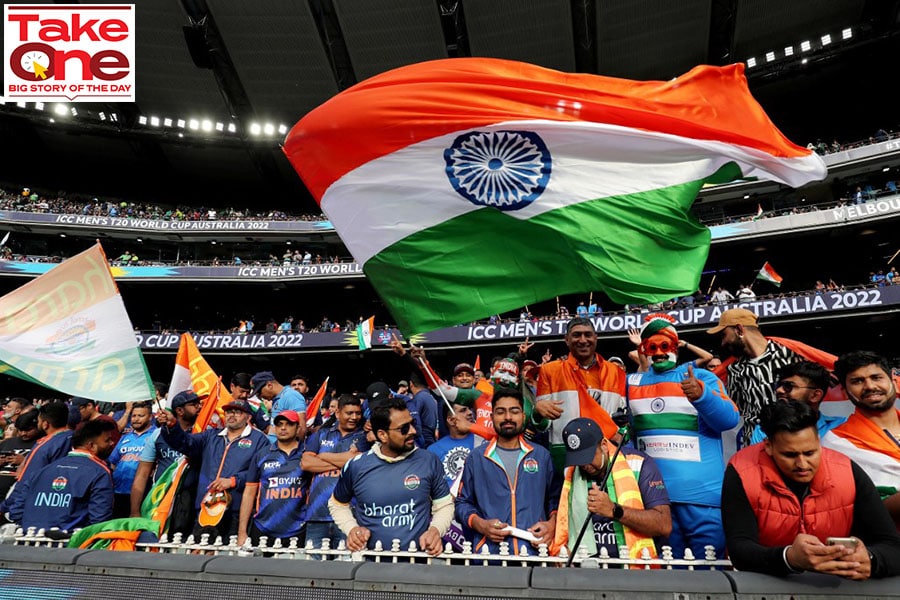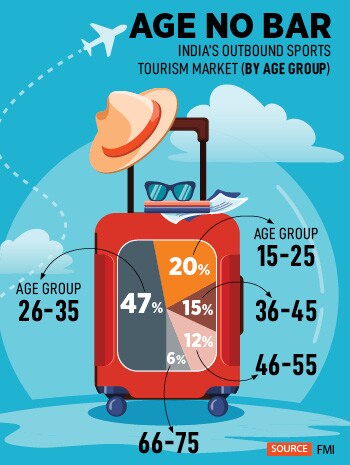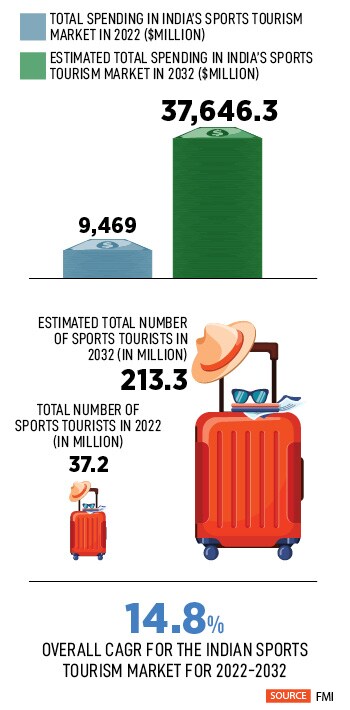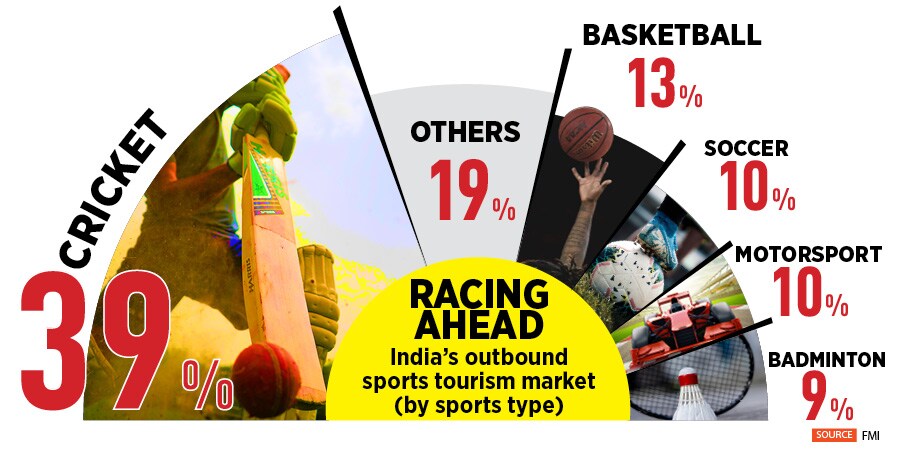
Fun and Games: How sports tourism is picking up pace in India
By Kathakali Chanda| Nov 10, 2022
As nearly 20,000 fans travel to Australia for the T20 World Cup, and many more line up for the FIFA World Cup beginning this month, sports becomes the first segment within tourism to shake off the Covid-induced stasis
 [CAPTION]Indian fans cheer during the ICC men's Twenty20 World Cup 2022 match between India and Pakistan at Melbourne Cricket Ground in Melbourne on October 23, 2022.
Photo:
Surjeet Yadav / AFP[/CAPTION]
[CAPTION]Indian fans cheer during the ICC men's Twenty20 World Cup 2022 match between India and Pakistan at Melbourne Cricket Ground in Melbourne on October 23, 2022.
Photo:
Surjeet Yadav / AFP[/CAPTION]
Among the thousands bringing the roof down in Adelaide, where India takes on England in the semifinal of the T20 World Cup, will be Rakesh Patel and his army of travelling fans, who are tailing Team India with flags, dholaks and their indefatigable vocal chords. It’s a journey Patel has been on since the 1999 ODI World Cup in England—when he bumped into three kindred souls and decided to get together during the India-Pakistan tie to amp up the decibels at Old Trafford, where the high-octane match was being held. Once the tournament wrapped up, Patel launched the Bharat Army, which would gather for every India match to drum up support from the stands.
In 2015, the Bharat Army snowballed into a group of 500 that travelled to Australia for the ODI World Cup. “Back then, we had no commercial interests in mind. But during this trip, we had to manage tickets, stays, excursions for this large group,” says Patel, now a resident of London. “When I returned, I thought we had an opportunity to build something from this.” That’s when the 47-year-old launched the Bharat Army Travel & Tours, a sports tourism and hospitality vertical that curates travel packages themed on sporting experiences.
_RSS_In 2017, it became an International Cricket Council (ICC)-accredited agency and gathered around 1,200 Indian cricket fans from around the world to showcase the Champion’s Trophy in England. “In 2019, for the ODI World Cup, the number jumped to 11,500-odd,” says Patel. It's a number he is looking to repeat for next year's ODI World Cup to be held in India. “A lot of Indians abroad are saving up for the tournament to be held in India, the game’s spiritual home, and I am expecting to bring in a 10,000+ contingent,” he says.
Not just with non-residents, but within India too, sports tourism is on the upswing and sporting events have turned out to be an accelerator for driving demand for travel, especially post-pandemic. With rising disposable income and a growing awareness, Indian sports fans are crisscrossing the world to watch events ranging from cricket and football to tennis, F1, basketball, golf and even rugby.
According to a report by market analysts Future Market Insights (FMI), the total spending in the Indian sports tourism market that was pegged at $9,469 million in 2022 is expected to rise to $37,646.3 million in 2032 at a CAGR of 14.8 percent; during this period, the number of sports tourists will go up from 37.2 million to 213.3 million. Of this, while the inbound market has a growth prediction of 9.4 percent, outbound is nearly double at 17.4 percent. Says Sneha Varghese, senior manager, FMI: “Post-pandemic, sports is the first segment within tourism to ease out. Of the entire outbound travel market, 10-12 percent are sports travellers. Five years ago, this number would have been barely 5-7 percent.”  “There are a lot of investments being done in the sports culture in the country. There’s an ecosystem of sports marketing, a lot of startups have come up, plus there is a government thrust on sports as events like Khelo India and the National Games are being broadcast,” says Neeraj Singh Dev, senior vice president-ecommerce India and shorthaul holidays, Thomas Cook India. “All these factors will ensure sports tourism will grow at a brisk pace.”
“There are a lot of investments being done in the sports culture in the country. There’s an ecosystem of sports marketing, a lot of startups have come up, plus there is a government thrust on sports as events like Khelo India and the National Games are being broadcast,” says Neeraj Singh Dev, senior vice president-ecommerce India and shorthaul holidays, Thomas Cook India. “All these factors will ensure sports tourism will grow at a brisk pace.”
While pent-up demand following a two-year-long, Covid-induced shutdown has been a key factor this year, a chock-a-block sports calendar with marquee events like the ICC T20 Men’s World Cup in Australia and the quadrennial FIFA World Cup in Qatar have also helped in spurring sports tourism. “For the 2014 soccer World Cup in Brazil, we had taken barely a few hundred Indians,” says Naveen Kundu, managing director, Ebixcash travel group. “At the 2018 edition in Russia, where we were a sub-agent for FIFA hospitality, the number had shot up drastically.”
According to news reports, while around 18,000 Indians had travelled to Russia for the event, as of September, nearly 23,500 out of the 1.8 million tickets for the current edition beginning in Qatar mid-November have been bought by Indians. That makes India the seventh-largest country in terms of ticket sales, a significant number considering the home team hasn’t even qualified for the tournament.
Adds Singh Dev: “Indians are among the top buyers for FIFA and T20 World Cup tickets and, currently, 10 percent of our outbound travellers travel specifically for sports. This is expected to witness a 20 percent year-on-year growth.”
Also read: Eyeing tourism boom, Saudi Arabia scrambles to train hotel staff

Going For The Experience
The pursuit of experiential travel lies at the core of why sports tourism is seeing an uptick in India. More and more Indians are looking to indulge that itch to nurture their interests, and check bucket lists, instead of just exploring a city. Visiting, say, Amsterdam during a Harry Styles concert, or a trip to Paris that includes watching Lionel Messi play for local club PSG. Which is why the highest premium is always placed on the most elite of matches. Like an India-Pakistan clash for the T20 World Cup that, says Daniel D’Souza, president & country head-holidays, SOTC Travel, sold out within hours.“There has been a 50-60 percent growth in travellers for this T20 World Cup since this was the first major sporting event after Covid,” says D’Souza. “Inquiries for top sports events have been growing at close to 30-40 percent every year. This year, given the pent-up demand, I would peg it at close to 70 percent.”
 With sports tourism exploding as a market, a number of official tour operators are adding money-can’t-buy experiences to packages to lure the discerning customer. How about a seat in front of the Indian dressing room at the SCG, a yacht party with Brett Lee or a photo-op with a Barca great during a visit to Camp Nou? Travel companies are throwing it all in. “The charm of going with these operators is the events. A day before the 2019 World Cup final, one of the companies organised a meet-and-greet with cricket greats Clive Lloyd, Sunil Gavaskar and Michael Clarke at The Oval. Imagine what it can do to a fan,” says Rishee Chhabra, an inveterate traveller and founder of Pitch Memorabilia, a collection of exclusive autographed cricket merchandise.
With sports tourism exploding as a market, a number of official tour operators are adding money-can’t-buy experiences to packages to lure the discerning customer. How about a seat in front of the Indian dressing room at the SCG, a yacht party with Brett Lee or a photo-op with a Barca great during a visit to Camp Nou? Travel companies are throwing it all in. “The charm of going with these operators is the events. A day before the 2019 World Cup final, one of the companies organised a meet-and-greet with cricket greats Clive Lloyd, Sunil Gavaskar and Michael Clarke at The Oval. Imagine what it can do to a fan,” says Rishee Chhabra, an inveterate traveller and founder of Pitch Memorabilia, a collection of exclusive autographed cricket merchandise.
Such a package (that includes match tickets, stay and cutting-edge experiences) attracts a premium too, about 3-4x of regular tickets. A FIFA hospitality box ticket that includes a four- to five-day stay in Qatar would typically set you back by Rs5-6 lakh, says D’Souza of SOTC Travel. Add to that soaring inflation, rising fuel costs, the dollar-to-rupee cost, and sports tourism could seem to be a preserve of the well-heeled. In fact, sports travel is galvanised by HNIs and MICE (meetings, incentives, conferences and exhibitions), with many operators pegging its share at 70 percent. Thomas Cook India’s Singh Dev says they have seen a 35-40 percent surge in demand for the T20 World Cup in Australia, with several mid- to large-size corporate MICE groups sending teams of between 100 and 700.
While the two categories still garner the lion’s share, a third, that of leisure travellers and sports fans, is slowly picking pace. Take, for instance, Monish Shah, a former investment banker and a Chelsea fanatic, who would frequently visit London on work, but would often fail to score a ticket for a match at Stamford Bridge, the home ground of his favourite club. “There were no official partners or exclusive ticketing agents in India, and having reached London last minute, the tickets would be sold out. That’s when I realised the vast opportunity in the Indian market, of giving consumers access to the best sporting events worldwide,” says Shah, now the founder of DreamSetGo, a premium sports experiences and travel platform.
DreamSetGo, which was launched in 2019 under the Dream Sports group, has ferried 10-20 percent of the nearly-20,000-strong fans who have travelled to Australia for the T20 World Cup. Shah, meanwhile, has his cake and eats it too, turning his passion into his profession while ensuring he gets the best experience during his sports holidays (“which would be at least one, if I take two trips in a year,” he says).
Also read: FIFA World Cup ticket sales approach 2.5 million: report

It's Not Just Cricket
It’s perhaps a given that much of the sports tourism in India is driven by cricket. According to the FMI report, 39 percent of India’s outbound sports tourists are headed to cricket tournaments. Kundu, who had founded the Leisure Travel Group with an eye on capturing the experiential tourism market, had taken 200-odd people to the 1999 cricket World Cup in England, of them mostly corporates sending people on incentive tours. Twenty years later, now as part of the Ebixcash group, his company, an official travel agent for the ICC, sent 4,500 Indians to the island nation for the ODI World Cup in 2019.But, a surprise second on the list is basketball, while motorsport comes in third along with soccer. A number of young Indians are taking to the F1 races, especially those closer home—in Singapore and Abu Dhabi, for instance—with a roundtrip over a weekend. “For every F1 event, we see about 25-30 percent growth in travellers. It never used to happen in the past,” says D’Souza of SOTC Travel.

The Singapore Grand Prix that was held on October 2 saw a record attendance of 302,000 spectators over the race weekend, the highest since the inaugural night race in 2008. “At least 40 percent of those spectators were international travellers, many of them Indians, who attended the race as well as the concert over the weekend,” says GB Srithar, regional director, India, Middle East, South Asia and Africa, Singapore Tourism Board.
The tourism boards have picked up on the trend, and are rolling out measures to woo the sports travellers. For the T20 World Cup in Australia, the department of home affairs has extended personalised and streamlined visa services for corporate incentive groups and ICC’s official travel and hospitality agents. “Direct flights on the India-Australia route have tripled, from eight per week in 2019 to 24 in 2022, with Air India and Qantas running non-stop services. Airlines have reported a strong forward demand and load factors over the next few months. This pent-up demand is likely due to a surge in visitation for sporting events, including the ICC men’s T20 World Cup,” says Nishant Kashikar, country manager (India & Gulf), Tourism Australia.

Adds Kashikar: “About 18,000-20,000 Indians are expected to have travelled for the T20 World Cup. The number is double that of the 2015 World Cup, which was the biggest sporting event in the country since the Sydney Olympics in 2000.” In a report shared by the ICC, he further says, over 16,000 tickets have been purchased by Indians (as of the third week of October), making them the third-largest nationality in terms of ticket sales after Australians and Britons.
The explosion of Indian sports tourism is best captured in what Patel of the Bharat Army has to say about his travel experiences. When he first started visiting away tournaments in the 90s, to far-off places, including Australia and the West Indies, Patel recalls he would perhaps be the only Indian fan staying in the same hotel as the players. “If you turn up now, you’ll never get a room in those hotels,” he says.